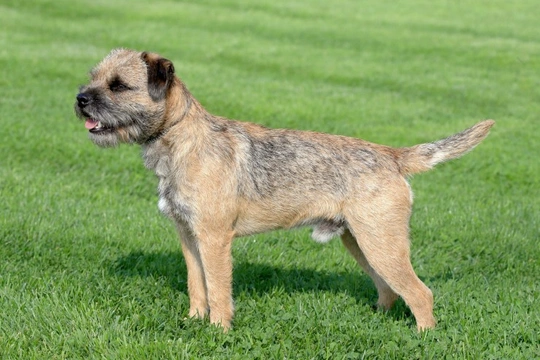
All about terriers
A terrier is any dog of a wide variety of breeds which were originally bred and trained to hunt rodents and vermin such as rats, foxes, rabbits, stoats and weasels. The name comes from the Latin word ‘terra’ meaning ‘earth,’ and refers to the ability of the terrier to pursue their prey underground into bolt holes and burrows. The terrier group is one of the UK Kennel Club’s seven dog grouping classifications for showing purposes, although the term terrier encompasses a much wider variety of dogs of both pure and mixed breed which are not included within the Kennel Club breed register. Terriers come in many different breed subsections and hail from all over the world, but are generally always small, lively and intelligent dogs which are renowned for being fearless and bold, and have a single minded concentration and commitment to chasing and killing their prey.
Different types of terriers
Traditionally, English terriers of different breeds were simply classified as either long or short legged, but today, the terrier grouping is broken down into four additional subsections categorised by their size and working function.
Working terriers (Fell terriers and hunt terriers)
Working terriers or hunter type terriers include breeds such as the Jack Russell and Patterdale terrier and were traditionally used to track and kill their quarry both above ground and into burrows and bolt holes. The working terrier designation is broken down into the groups of fell terriers and hunt terriers; Fell terrier breeds were developed in the North of England to assist in the control of foxes.Hunt terriers were commonly used across the UK before hunting with dogs was outlawed, and terriers of this type often accompanied hounds alongside of a mounted hunt to pursue foxes into their burrows.
Toy terriers
Toy terriers refers to companion dogs with origins in various other original terrier breeds which have been selectively bred down into smaller dogs of a toy dog type, such as the Yorkshire terrier and the English toy terrier. While they may be small in size, these half pint terrier breeds still retain all of the pluck, courage and big dog personalities of their full sized counterparts!
Bull type terriers
The bull terrier dog breeds initially came into existence as a result of the selective mating of terrier type dogs and bulldogs, to combine the desirable characteristics of both breeds into one dog. Initially produced for such unsavoury pastimes such as dog fighting and bull baiting, a variety of dog breeds and types such as the Staffordshire bull terrier and the standard bull terrier (as well as the pit bull terrier which is currently illegal to own or breed in the UK due to it’s inclusion on the Dangerous Dogs Act list of banned breeds) have endured throughout the centuries despite the banning of dog fighting blood sports, and are now well regarded and popularly owned as companion animals and pets across the world.
The Kennel Club terrier breed list
For showing and competition purposes, The Kennel Club in the UK recognises twenty six different pure bred terrier type dogs within the overall terrier grouping. The list of terrier dogs consists of:
- Airedale Terrier
- Australian Terrier
- Bedlington Terrier
- Border Terrier
- Bull Terrier
- Bull Terrier (Miniature)
- Cairn Terrier
- Cesky Terrier
- Dandie Dimont Terrier
- Fox Terrier (Smooth coated)
- Fox Terrier (Wire coated)
- Glen of Imaal Terrier
- Irish Terrier
- Kerry Blue Terrier
- Lakeland Terrier
- Manchester Terrier
- Norfolk Terrier
- Norwich Terrier
- Parson Russell Terrier
- Scottish Terrier
- Sealyham Terrier
- Skye Terrier
- Soft Coated Wheaten Terrier
- Staffordshire Bull Terrier
- Welsh Terrier
- West Highland White Terrier
History of terrier type dogs
Pure breed and mixed breed dogs of the terrier type or with terrier origins can be found across the world, with some dogs staying very true to their originally bred conformation and working origins and some bred down into companion animals or dogs of a size and type so as to be almost unrecognisable next to their historical counterparts.Recent genetic testing and DNA analysis indicates that most modern dogs of the terrier type developed from within the same relatively small gene pool of European ancestors during the 19th century. Some terrier breeds and dogs of the terrier type fall under the ‘mastiff’ dog classification, alongside other large headed breeds such as the Labrador retriever and the Pomeranian. The Tibetan terrier dog, despite its name, is not a true terrier at all, but was given the misnomer of terrier due to its approximate physical similarities to dogs from within the terrier grouping, and is actually more closely related to the Pekingese dog than it is to any of the true terrier breeds.
The terrier personality
Terriers are almost always alert, bright dogs with bags of personality, which makes them popular with both families and people with active lifestyles. Although many terriers are small in stature, they do tend to have a very ‘big dog’ personality and often show no fear in taking on or facing up to other dogs of a much larger size! Terriers can sometimes be unruly and stubborn if inadequately trained and controlled, and may on occasion display aggressive or dominant traits in a pack situation, although this is generally something which can be managed through training.Terriers are very active and easily bored, and require a lot of stimulation and interaction with people in order to keep them entertained. Bright and loyal, the terrier is relatively easy to train and keen to please, and is adaptable to a wide variety of situations. They are relatively hardy dogs, and are not unduly bothered by the vagaries of the British weather.



